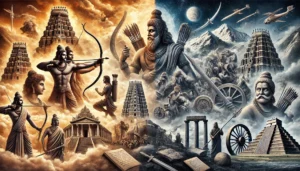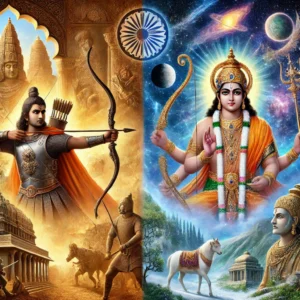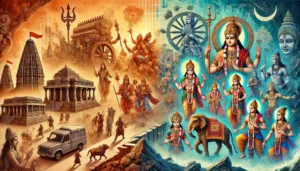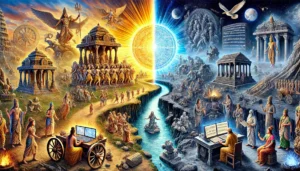
Is Mahabharat a historical event or myth?
Are the Mahabharata and Ramayana Historical Events?
The Mahabharata and the Ramayana are not merely epic tales but foundational pillars of Indian culture and spirituality. These texts have shaped the moral compass, traditions, and worldviews of countless generations. While their spiritual significance is unquestionable, their historicity has long been a topic of passionate debate. Are they purely allegorical, or are they historical accounts with elements of myth and divine intervention? This article delves deeper into the evidence, theories, and perspectives surrounding this intriguing question.
The Mahabharata: Historical Epic or Divine Allegory?
The Mahabharata, attributed to sage Vyasa, is not just a tale of a great war but also an encyclopedic document of ancient Indian life. It combines history, philosophy, ethics, and spirituality in over 100,000 verses, making it the longest epic in world literature.
Geographical Precision
The epic mentions numerous places that exist today, such as Hastinapura, Kurukshetra, Indraprastha, and Dwarka. These are not merely vague references but detailed descriptions of cities, rivers, and landscapes. For example:
Hastinapura: Excavations have revealed remnants of settlements in this region that match the descriptions in the Mahabharata. Layers of pottery and urban planning suggest continuous habitation dating back to 1200 BCE.
Kurukshetra: Known as the battlefield of the great war, Kurukshetra remains a significant pilgrimage site, with landmarks like Jyotisar, believed to be where Lord Krishna delivered the Bhagavad Gita.
Astronomical Evidence
The Mahabharata includes detailed celestial observations, particularly during the Kurukshetra War. Researchers have used these planetary alignments and eclipses to date the events.
Dr. R. N. Iyengar, a noted researcher, estimated the war occurred around 1478 BCE.
Other scholars, using astronomical software, suggest dates as early as 3100 BCE.
Though these findings are compelling, they depend on interpretations of ancient texts and astronomical models, making them subject to debate.
Table of Contents

Is Mahabharat a historical event or myth?
Submerged City of Dwarka
Dwarka, the kingdom of Lord Krishna, is described as a magnificent city submerged under the sea. Marine archaeologists have discovered underwater structures off the coast of Gujarat, which align with these descriptions. Carbon dating places the artifacts at around 1500 BCE, offering tantalizing hints of an advanced civilization that might have inspired Krishna’s Dwarka.
Cultural Legacy
The Mahabharata’s impact on Indian society, literature, and philosophy is unmatched. Its moral dilemmas and teachings, like the Bhagavad Gita, resonate universally. Such influence suggests that it may have been rooted in real events, later mythologized to convey profound truths.
The Ramayana: Divine Legend or Historical Record?
The Ramayana, composed by Valmiki, narrates the life of Lord Rama, his exile, and his quest to rescue Sita from Ravana, the king of Lanka. This tale has transcended borders, influencing cultures across Southeast Asia, including Thailand, Cambodia, and Indonesia, where their own versions of the epic exist.
Geographical Consistency
The Ramayana describes numerous locations along Rama’s journey:
Ayodhya: Considered the birthplace of Lord Rama, Ayodhya holds immense historical and spiritual significance. Archaeological excavations have unearthed evidence of ancient temples, hinting at continuous habitation over millennia.
Rameshwaram and Ram Setu: The Ram Setu, or Adam’s Bridge, a chain of limestone shoals connecting India and Sri Lanka, is often associated with the bridge built by Rama’s army. Scientific studies suggest this formation is over 7,000 years old. While its construction remains debated, the alignment with the epic’s timeline is striking.
Archaeological Evidence in Sri Lanka
Artifacts found in Sri Lanka, such as ancient tools and inscriptions, have been linked to Ravana’s era in local folklore. Sites like Sigiriya, believed to be Ravana’s fortress, add layers to the historical narrative.
Astronomical Dating
The Ramayana contains celestial references, such as planetary positions during Rama’s birth. Researchers using software like Planetarium have dated these events to approximately 5114 BCE. While fascinating, these calculations rely on interpretations of poetic descriptions.

Is Mahabharat a historical event or myth?
Symbolism and Allegory in the Epics
Both epics contain divine interventions, miraculous events, and larger-than-life characters. Critics argue that such elements place them firmly in the realm of mythology. However, ancient Indian literature often blends historical events with spiritual symbolism to impart ethical and philosophical lessons.
Mahabharata: The war symbolizes the eternal conflict between dharma (righteousness) and adharma (unrighteousness).
Ramayana: Rama represents the ideal human being, embodying virtues like truth, compassion, and justice.
Even if the events are not strictly historical, their allegorical significance remains unparalleled.
Scientific Tools and Modern Investigations
Modern science offers new methods to probe the historicity of these epics:
Archaeology: Excavations at Hastinapura, Ayodhya, and Dwarka provide valuable insights into ancient Indian civilizations, though direct links to the epics are challenging to establish.
Carbon Dating: Objects unearthed from Dwarka and Ayodhya have been carbon-dated to time periods that align with the Mahabharata and Ramayana timelines.
Astronomy: Sophisticated software allows researchers to simulate ancient skies, offering potential dates for events described in the epics.
Marine Archaeology: Underwater explorations near Dwarka reveal submerged structures that could redefine our understanding of ancient India.
Mythology or History? Finding the Balance
Historical View: The detailed geographical and political descriptions in the epics suggest they could be based on real events. The epics may have recorded actual dynasties and conflicts, later infused with spiritual and mythological elements.
Mythological Perspective: Skeptics argue that the miraculous events, divine characters, and allegorical lessons place the epics firmly in the realm of mythology.
Blended Approach: A balanced view considers that the Mahabharata and Ramayana could be historical events heavily embellished over time, much like how ancient records of Troy inspired Homer’s Iliad.
Conclusion
The Mahabharata and Ramayana are more than mere stories; they are timeless guides to life, filled with lessons on dharma, morality, and human values. Whether historical or mythological, their impact on Indian and global culture is undeniable. As science continues to uncover more about ancient civilizations, the line between myth and history may blur further. Until then, these epics will remain as both spiritual beacons and historical mysteries, inviting readers to explore their depths.
Their true significance lies not in whether they happened exactly as described, but in how they continue to inspire humanity with their timeless wisdom.

Is Mahabharat a historical event or myth?
FAQs for “Mahabharata and Ramayana: Mythology or Historical Reality?”:
1. What are the Mahabharata and Ramayana?
The Mahabharata and Ramayana are two of the greatest epics of ancient India, written in Sanskrit.
The Mahabharata, attributed to Sage Vyasa, is the longest epic in the world, with over 100,000 verses. It narrates the story of the Kurukshetra War, the moral dilemmas of its participants, and the philosophical teachings, including the Bhagavad Gita.
The Ramayana, attributed to Sage Valmiki, tells the tale of Lord Rama’s life, his 14-year exile, his wife Sita’s abduction by Ravana, and the eventual victory of good over evil.
2. Are the Mahabharata and Ramayana purely mythological?
They are traditionally viewed as a mix of itihasa (history) and mythology.
While the divine and supernatural elements, such as flying chariots, curses, and boons, are seen as symbolic or exaggerated, the geographical, societal, and cultural details align closely with ancient Indian history.
3. Is there archaeological evidence supporting their historicity?
Several archaeological sites correspond to locations mentioned in the epics:
Excavations at Hastinapur have uncovered settlements dating back to 1200–800 BCE, aligning with the timeline proposed for the Mahabharata.
At Kurukshetra, artifacts suggest an ancient battlefield, though direct evidence linking it to the Mahabharata war is lacking.
In Ayodhya, findings of ancient temple remains support claims of it being Rama’s birthplace.
Despite these discoveries, critics argue the lack of direct and indisputable evidence tying these locations to the exact events described in the epics.
4. What role does astronomy play in validating these epics?
Ancient Indian texts often include precise astronomical details, such as planetary positions and eclipses, which researchers have used to date events.
For example:
Using planetary alignments in the Mahabharata, some researchers have proposed the Kurukshetra War occurred around 3138 BCE.
Similarly, astronomical data in the Ramayana places events like Rama’s exile and the war with Ravana around 5075 BCE.
However, these dates are debated due to variations in interpretations of the texts and limitations of current astronomical software.
5. Are there mentions of these epics in other ancient texts?
Yes, references to the Mahabharata and Ramayana are found in:
Puranas (e.g., Vishnu Purana and Bhagavata Purana).
Jain texts, which have alternative versions of the Ramayana.
Buddhist literature, like the Dasharatha Jataka, which recounts a version of Rama’s story.
These references demonstrate the widespread influence of these epics across cultures and eras.
6. How do Indian traditions view these epics?
In Indian culture, the Mahabharata and Ramayana are considered sacred texts, seen as a blend of historical narratives and moral lessons.
They are believed to reflect not just historical events but also timeless truths about human nature, dharma (duty), and societal values.
7. What are some key locations tied to these epics?
Many locations mentioned in the epics still hold religious and cultural significance:
Hastinapur: The capital of the Kuru dynasty.
Kurukshetra: The battlefield of the Mahabharata war.
Ayodhya: Lord Rama’s birthplace.
Chitrakoot: The forest where Rama spent part of his exile.
Lanka: Believed to correspond to modern-day Sri Lanka, where Ravana ruled.
Pilgrimage to these sites continues to this day, demonstrating their enduring importance.
8. How have modern historians and scientists approached these epics?
Researchers use various tools, including:
Archaeology: Excavations at relevant sites.
Astronomy: Analyzing celestial events described in the texts.
Geography: Mapping locations to current landscapes.
Linguistics: Studying the evolution of language in the epics to estimate their timelines.
Opinions remain divided, with some scholars viewing the epics as historical records and others as symbolic narratives.
9. Are there global parallels to these epics?
Many ancient cultures have epic narratives with themes similar to those in the Mahabharata and Ramayana:
Iliad and Odyssey (Greece): Themes of war, loyalty, and divine intervention.
Epic of Gilgamesh (Mesopotamia): A hero’s journey with moral and spiritual undertones.
These similarities suggest a universal human tendency to encode cultural values and history into epic stories.
10. Why is there debate over their historicity?
The debate arises because:
The epics include detailed descriptions of real places and societal practices, suggesting historical grounding.
Simultaneously, they feature supernatural events and divine interventions, which critics argue are mythological embellishments.
This duality makes it challenging to classify them as purely historical or purely mythical.
11. What do ancient Indian texts say about their historicity?
The Mahabharata describes itself as an itihasa (historical account), and the Ramayana is referred to as an adi-kavya (the first poem).
These classifications indicate that ancient Indians regarded these texts as historical records rather than fiction.
12. Why are these epics still relevant today?
Their teachings on dharma (righteousness), karma (actions), and devotion are timeless.
Lessons such as perseverance in adversity (from Rama’s life) and ethical dilemmas (in the Mahabharata) resonate across cultures and eras.
Beyond spiritual lessons, the epics provide insights into ancient governance, warfare, family dynamics, and societal structures.
13. How do the Mahabharata and Ramayana influence modern culture?
They inspire art, literature, theater, and cinema.
Television adaptations like Ramanand Sagar’s Ramayana and B.R. Chopra’s Mahabharata have brought the epics into the modern household.
Festivals like Diwali (celebrating Rama’s return to Ayodhya) and Dussehra (symbolizing the victory of good over evil) are rooted in these stories.
14. What are some symbolic interpretations of the epics?
The Ramayana is often seen as an allegory of the victory of good (Rama) over evil (Ravana).
The Mahabharata can be interpreted as a reflection of life’s complexities, where even heroes have flaws, and decisions are rarely black and white.
These symbolic layers make the epics not just historical or religious texts but profound philosophical works.
15. Can modern technology help uncover more about these epics?
Yes, advancements in technology, such as:
Satellite imagery: To map ancient routes like the Ram Setu (Adam’s Bridge).
DNA studies: To trace migration patterns and confirm references in the texts.
Artificial Intelligence: To analyze and cross-reference the massive textual data in the epics for historical consistency.
Such tools offer promising avenues for further exploration.
Summary
The question of whether the Mahabharata and Ramayana are mythological tales or historical events has intrigued scholars, devotees, and historians for centuries. These epic narratives, central to Indian culture and spirituality, are rich in philosophical teachings, moral dilemmas, and detailed depictions of society, warfare, and governance.
Arguments for Mythology
Symbolic and Allegorical Themes: Many interpret the epics as allegorical stories conveying moral and spiritual truths rather than literal events. For example, the battle of Kurukshetra in the Mahabharata is often seen as a metaphor for the inner struggle between good and evil.
Inclusion of Supernatural Elements: Events like Ravana’s flying chariot (Pushpaka Vimana) in the Ramayana or Krishna’s cosmic form in the Mahabharata are often viewed as mythical embellishments.
Oral Traditions and Later Additions: Both epics evolved through centuries of oral storytelling, making it challenging to separate historical facts from imaginative additions.
Arguments for Historical Reality
Archaeological Evidence: Excavations in places like Kurukshetra and Dwarka (mentioned in the Mahabharata) have revealed artifacts and submerged ruins that some scholars link to these texts.
Geographical Accuracy: Many locations described in the epics, such as Ayodhya, Lanka, and Hastinapura, exist and align with their descriptions in the texts.
Astronomical References: The epics contain detailed astronomical data, such as planetary alignments and eclipses, which some researchers have used to date events, suggesting they could correspond to real timelines.
A Blend of Both?
Most contemporary perspectives recognize the epics as a fusion of history and mythology. They likely reflect historical events and societal structures of ancient India but were imbued with spiritual and cultural symbolism over time.
Ultimately, the Mahabharata and Ramayana transcend the debate of history versus mythology. Whether historical or not, their enduring significance lies in the timeless lessons they offer about duty, morality, and the human condition.
Related Articles
- The Tridevi: Lakshmi, Saraswati, and Parvati – Their Roles and Powers
- “Divine Creatures of Ancient Indian Scriptures: Exploring the Role of Animals in the Vedas, Puranas, and Mahabharata”
- Nature and Spirituality: Exploring the Sacred Essence of the Himalayas, Ganga, and Other Natural Wonders”
- “Reviving the Gurukul System: Relevance and Lessons for Modern Education”
- “Exploring Greek and Indian Mythology: Similarities Between Greek and Indian Mythology “
- “Embracing Sattvic Living: Harmonizing Mind, Body, and Soul Through Food and Lifestyle”
- “Charity and Prosperity: Exploring the Concept of Daan and Its Financial Relevance in Modern Life”
- How to Build an Eco-Friendly Home Inspired by Vastu Shastra
- Comparison of Ancient and Modern Sports: How Traditional Sports Have Influenced Contemporary Games
- “Timeless Lessons from Ancient Tales: Linking Samudra Manthan and Ganga’s Descent to Modern Ecological Challenges”
- “Reviving Sanskrit: How AI is Preserving Ancient Languages for the Future”
- “Mathura: The Sacred Land of Lord Krishna’s Divine Leelas”
- Investing for Future Generations: Lessons from Indian Traditions on Legacy Building and Wealth Preservation
- “Ancient Indian Wisdom: Timeless Lessons for Tackling Today’s Climate Crisis”
- “Artificial Intelligence and Spirituality: Transforming Ancient Practices for the Modern World”
- “Gold and Real Estate in India: Timeless Assets Shaping Financial Strategies”
- “Divine Feminine Power in Hindu Mythology: The Legends of Durga, Saraswati, and Lakshmi”
- “Divine Beings of Sanatan Dharma: The Spiritual Significance of Sacred Animals in Hinduism”
- “Symbolism in Mythological Art: Unlocking Hidden Meanings in Ancient Temple Carvings”
- “Exploring Technological Advancements in Ancient India and Civilizations: Vimana, Metallurgy, & Water Management systems”
- Unveiling the Mysteries: Ancient Temples of Sanatan Dharma , Mysterious Temples of India
- “The Scientific Knowledge of Sanatan Dharma: Ancient Wisdom Meets Modern Science”
- Ancient Indian Sports and Games: Celebrating a Legacy of Skill, Strength & Strategy”
- “Exploring the Cosmic Link: The Connection Between Astronomy and Vedic Astrology”
- The Power of Sanskrit: Unlocking the Divine Language of the Gods
- “The End of Kaliyuga: A Sanatan Insight into the World’s Final Chapter”
- Explore more articles on Prachin Sanatan Yuga.
